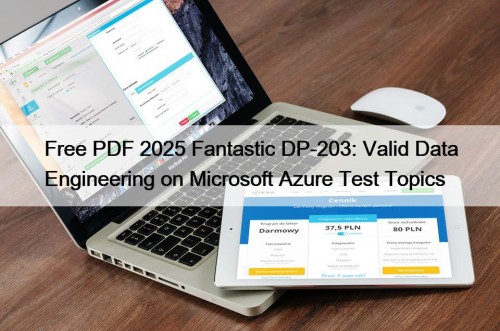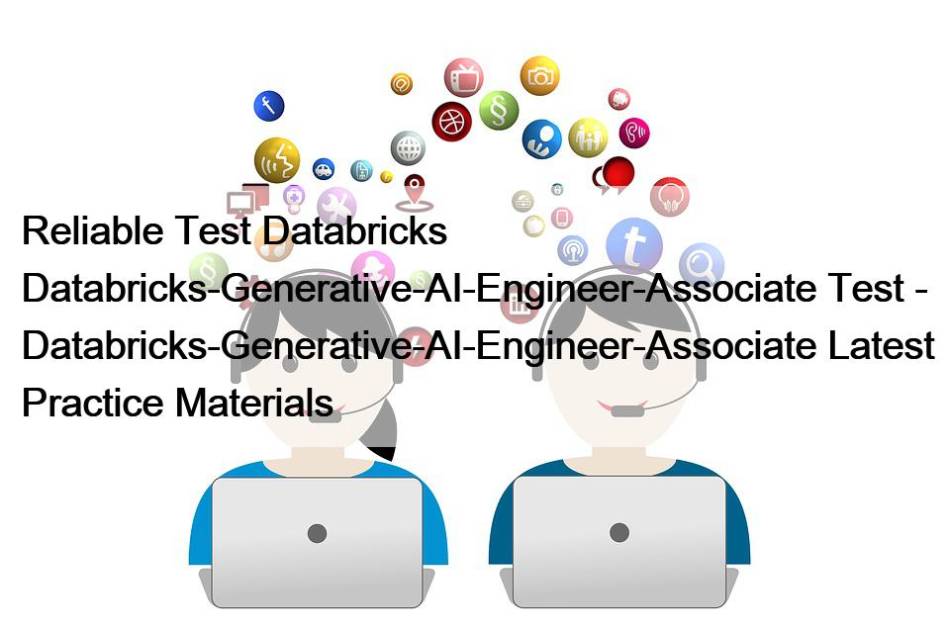Most Popular
 Free PDF 2025 Fantastic DP-203: Valid Data Engineering on Microsoft Azure Test Topics
Free PDF 2025 Fantastic DP-203: Valid Data Engineering on Microsoft Azure Test Topics
What's more, part of that BraindumpsVCE DP-203 dumps now are ...
 IBM C1000-170 Exam Dumps - Secret Hacks To Crack C1000-170 Exam
IBM C1000-170 Exam Dumps - Secret Hacks To Crack C1000-170 Exam
Our C1000-170 exam braindump is revised and updated according to ...
 Exam GB0-382 Course & GB0-382 Upgrade Dumps
Exam GB0-382 Course & GB0-382 Upgrade Dumps
H3C GB0-382 practice test has real H3CSE-RS-RT (GB0-382) exam questions. ...



Reliable Test Databricks Databricks-Generative-AI-Engineer-Associate Test - Databricks-Generative-AI-Engineer-Associate Latest Practice Materials

When you are studying for the Databricks-Generative-AI-Engineer-Associate exam, maybe you are busy to go to work, for your family and so on. How to cost the less time to reach the goal? It’s a critical question for you. Time is precious for everyone to do the efficient job. If you want to get good Databricks-Generative-AI-Engineer-Associate prep guide, it must be spending less time to pass it. Exactly, our product is elaborately composed with major questions and answers. We are choosing the key from past materials to finish our Databricks-Generative-AI-Engineer-Associate Guide Torrent. It only takes you 20 hours to 30 hours to do the practice. After your effective practice, you can master the examination point from the Databricks-Generative-AI-Engineer-Associate exam torrent. Then, you will have enough confidence to pass it.
Databricks Databricks-Generative-AI-Engineer-Associate Exam Syllabus Topics:
| Topic | Details |
|---|---|
| Topic 1 |
|
| Topic 2 |
|
| Topic 3 |
|
| Topic 4 |
|
| Topic 5 |
|
>> Reliable Test Databricks Databricks-Generative-AI-Engineer-Associate Test <<
Hot Reliable Test Databricks-Generative-AI-Engineer-Associate Test and High Pass-Rate Databricks-Generative-AI-Engineer-Associate Latest Practice Materials & Useful Certification Databricks Certified Generative AI Engineer Associate Test Answers
Our experts have experience of the exam for over ten years. So our Databricks-Generative-AI-Engineer-Associate practice materials are their masterpiece full of professional knowledge and sophistication to cope with the Databricks-Generative-AI-Engineer-Associate exam. They have sublime devotion to their career just like you, and make progress ceaselessly. By keeping close eyes on the current changes in this filed, they make new updates of Databricks-Generative-AI-Engineer-Associate Study Guide constantly and when there is any new, we will keep you noticed to offer help more carefully.
Databricks Certified Generative AI Engineer Associate Sample Questions (Q34-Q39):
NEW QUESTION # 34
A Generative Al Engineer is responsible for developing a chatbot to enable their company's internal HelpDesk Call Center team to more quickly find related tickets and provide resolution. While creating the GenAI application work breakdown tasks for this project, they realize they need to start planning which data sources (either Unity Catalog volume or Delta table) they could choose for this application. They have collected several candidate data sources for consideration:
call_rep_history: a Delta table with primary keys representative_id, call_id. This table is maintained to calculate representatives' call resolution from fields call_duration and call start_time.
transcript Volume: a Unity Catalog Volume of all recordings as a *.wav files, but also a text transcript as *.txt files.
call_cust_history: a Delta table with primary keys customer_id, cal1_id. This table is maintained to calculate how much internal customers use the HelpDesk to make sure that the charge back model is consistent with actual service use.
call_detail: a Delta table that includes a snapshot of all call details updated hourly. It includes root_cause and resolution fields, but those fields may be empty for calls that are still active.
maintenance_schedule - a Delta table that includes a listing of both HelpDesk application outages as well as planned upcoming maintenance downtimes.
They need sources that could add context to best identify ticket root cause and resolution.
Which TWO sources do that? (Choose two.)
- A. call_cust_history
- B. call_detail
- C. call_rep_history
- D. maintenance_schedule
- E. transcript Volume
Answer: B,E
Explanation:
In the context of developing a chatbot for a company's internal HelpDesk Call Center, the key is to select data sources that provide the most contextual and detailed information about the issues being addressed. This includes identifying the root cause and suggesting resolutions. The two most appropriate sources from the list are:
* Call Detail (Option D):
* Contents: This Delta table includes a snapshot of all call details updated hourly, featuring essential fields like root_cause and resolution.
* Relevance: The inclusion of root_cause and resolution fields makes this source particularly valuable, as it directly contains the information necessary to understand and resolve the issues discussed in the calls. Even if some records are incomplete, the data provided is crucial for a chatbot aimed at speeding up resolution identification.
* Transcript Volume (Option E):
* Contents: This Unity Catalog Volume contains recordings in .wav format and text transcripts in .txt files.
* Relevance: The text transcripts of call recordings can provide in-depth context that the chatbot can analyze to understand the nuances of each issue. The chatbot can use natural language processing techniques to extract themes, identify problems, and suggest resolutions based on previous similar interactions documented in the transcripts.
Why Other Options Are Less Suitable:
* A (Call Cust History): While it provides insights into customer interactions with the HelpDesk, it focuses more on the usage metrics rather than the content of the calls or the issues discussed.
* B (Maintenance Schedule): This data is useful for understanding when services may not be available but does not contribute directly to resolving user issues or identifying root causes.
* C (Call Rep History): Though it offers data on call durations and start times, which could help in assessing performance, it lacks direct information on the issues being resolved.
Therefore, Call Detail and Transcript Volume are the most relevant data sources for a chatbot designed to assist with identifying and resolving issues in a HelpDesk Call Center setting, as they provide direct and contextual information related to customer issues.
NEW QUESTION # 35
A Generative AI Engineer just deployed an LLM application at a digital marketing company that assists with answering customer service inquiries.
Which metric should they monitor for their customer service LLM application in production?
- A. HuggingFace Leaderboard values for the base LLM
- B. Number of customer inquiries processed per unit of time
- C. Final perplexity scores for the training of the model
- D. Energy usage per query
Answer: B
Explanation:
When deploying an LLM application for customer service inquiries, the primary focus is on measuring the operational efficiency and quality of the responses. Here's whyAis the correct metric:
* Number of customer inquiries processed per unit of time: This metric tracks the throughput of the customer service system, reflecting how many customer inquiries the LLM application can handle in a given time period (e.g., per minute or hour). High throughput is crucial in customer service applications where quick response times are essential to user satisfaction and business efficiency.
* Real-time performance monitoring: Monitoring the number of queries processed is an important part of ensuring that the model is performing well under load, especially during peak traffic times. It also helps ensure the system scales properly to meet demand.
Why other options are not ideal:
* B. Energy usage per query: While energy efficiency is a consideration, it is not the primary concern for a customer-facing application where user experience (i.e., fast and accurate responses) is critical.
* C. Final perplexity scores for the training of the model: Perplexity is a metric for model training, but it doesn't reflect the real-time operational performance of an LLM in production.
* D. HuggingFace Leaderboard values for the base LLM: The HuggingFace Leaderboard is more relevant during model selection and benchmarking. However, it is not a direct measure of the model's performance in a specific customer service application in production.
Focusing on throughput (inquiries processed per unit time) ensures that the LLM application is meeting business needs for fast and efficient customer service responses.
NEW QUESTION # 36
A Generative AI Engineer developed an LLM application using the provisioned throughput Foundation Model API. Now that the application is ready to be deployed, they realize their volume of requests are not sufficiently high enough to create their own provisioned throughput endpoint. They want to choose a strategy that ensures the best cost-effectiveness for their application.
What strategy should the Generative AI Engineer use?
- A. Switch to using External Models instead
- B. Throttle the incoming batch of requests manually to avoid rate limiting issues
- C. Deploy the model using pay-per-token throughput as it comes with cost guarantees
- D. Change to a model with a fewer number of parameters in order to reduce hardware constraint issues
Answer: C
Explanation:
* Problem Context: The engineer needs a cost-effective deployment strategy for an LLM application with relatively low request volume.
* Explanation of Options:
* Option A: Switching to external models may not provide the required control or integration necessary for specific application needs.
* Option B: Using a pay-per-token model is cost-effective, especially for applications with variable or low request volumes, as it aligns costs directly with usage.
* Option C: Changing to a model with fewer parameters could reduce costs, but might also impact the performance and capabilities of the application.
* Option D: Manually throttling requests is a less efficient and potentially error-prone strategy for managing costs.
OptionBis ideal, offering flexibility and cost control, aligning expenses directly with the application's usage patterns.
NEW QUESTION # 37
A Generative AI Engineer is creating an agent-based LLM system for their favorite monster truck team. The system can answer text based questions about the monster truck team, lookup event dates via an API call, or query tables on the team's latest standings.
How could the Generative AI Engineer best design these capabilities into their system?
- A. Write a system prompt for the agent listing available tools and bundle it into an agent system that runs a number of calls to solve a query.
- B. Instruct the LLM to respond with "RAG", "API", or "TABLE" depending on the query, then use text parsing and conditional statements to resolve the query.
- C. Build a system prompt with all possible event dates and table information in the system prompt. Use a RAG architecture to lookup generic text questions and otherwise leverage the information in the system prompt.
- D. Ingest PDF documents about the monster truck team into a vector store and query it in a RAG architecture.
Answer: A
Explanation:
In this scenario, the Generative AI Engineer needs to design a system that can handle different types of queries about the monster truck team. The queries may involve text-based information, API lookups for event dates, or table queries for standings. The best solution is to implement atool-based agent system.
Here's how option B works, and why it's the most appropriate answer:
* System Design Using Agent-Based Model:In modern agent-based LLM systems, you can design a system where the LLM (Large Language Model) acts as a central orchestrator. The model can "decide" which tools to use based on the query. These tools can include API calls, table lookups, or natural language searches. The system should contain asystem promptthat informs the LLM about the available tools.
* System Prompt Listing Tools:By creating a well-craftedsystem prompt, the LLM knows which tools are at its disposal. For instance, one tool may query an external API for event dates, another might look up standings in a database, and a third may involve searching a vector database for general text-based information. Theagentwill be responsible for calling the appropriate tool depending on the query.
* Agent Orchestration of Calls:The agent system is designed to execute a series of steps based on the incoming query. If a user asks for the next event date, the system will recognize this as a task that requires an API call. If the user asks about standings, the agent might query the appropriate table in the database. For text-based questions, it may call a search function over ingested data. The agent orchestrates this entire process, ensuring the LLM makes calls to the right resources dynamically.
* Generative AI Tools and Context:This is a standard architecture for integrating multiple functionalities into a system where each query requires different actions. The core design in option B is efficient because it keeps the system modular and dynamic by leveraging tools rather than overloading the LLM with static information in a system prompt (like option D).
* Why Other Options Are Less Suitable:
* A (RAG Architecture): While relevant, simply ingesting PDFs into a vector store only helps with text-based retrieval. It wouldn't help with API lookups or table queries.
* C (Conditional Logic with RAG/API/TABLE): Although this approach works, it relies heavily on manual text parsing and might introduce complexity when scaling the system.
* D (System Prompt with Event Dates and Standings): Hardcoding dates and table information into a system prompt isn't scalable. As the standings or events change, the system would need constant updating, making it inefficient.
By bundling multiple tools into a single agent-based system (as in option B), the Generative AI Engineer can best handle the diverse requirements of this system.
NEW QUESTION # 38
A team wants to serve a code generation model as an assistant for their software developers. It should support multiple programming languages. Quality is the primary objective.
Which of the Databricks Foundation Model APIs, or models available in the Marketplace, would be the best fit?
- A. CodeLlama-34B
- B. BGE-large
- C. MPT-7b
- D. Llama2-70b
Answer: A
Explanation:
For a code generation model that supports multiple programming languages and where quality is the primary objective,CodeLlama-34Bis the most suitable choice. Here's the reasoning:
* Specialization in Code Generation:CodeLlama-34B is specifically designed for code generation tasks.
This model has been trained with a focus on understanding and generating code, which makes it particularly adept at handling various programming languages and coding contexts.
* Capacity and Performance:The "34B" indicates a model size of 34 billion parameters, suggesting a high capacity for handling complex tasks and generating high-quality outputs. The large model size typically correlates with better understanding and generation capabilities in diverse scenarios.
* Suitability for Development Teams:Given that the model is optimized for code, it will be able to assist software developers more effectively than general-purpose models. It understands coding syntax, semantics, and the nuances of different programming languages.
* Why Other Options Are Less Suitable:
* A (Llama2-70b): While also a large model, it's more general-purpose and may not be as fine- tuned for code generation as CodeLlama.
* B (BGE-large): This model may not specifically focus on code generation.
* C (MPT-7b): Smaller than CodeLlama-34B and likely less capable in handling complex code generation tasks at high quality.
Therefore, for a high-quality, multi-language code generation application,CodeLlama-34B(option D) is the best fit.
NEW QUESTION # 39
......
It is a popular belief that only processional experts can be the leading one to do some adept job. And similarly, only high quality and high accuracy Databricks-Generative-AI-Engineer-Associate exam questions like ours can give you confidence and reliable backup to get the certificate smoothly because our experts have extracted the most frequent-tested points for your reference. Our Databricks-Generative-AI-Engineer-Associate exam questions generally raised the standard of practice materials in the market with the spreading of higher standard of knowledge in this area. So your personal effort is brilliant but insufficient to pass the Databricks Certified Generative AI Engineer Associate exam and our Databricks-Generative-AI-Engineer-Associate Test Guide can facilitate the process smoothly & successfully. Our Databricks Certified Generative AI Engineer Associate practice materials are successful by ensuring that what we delivered is valuable and in line with the syllabus of this exam.
Databricks-Generative-AI-Engineer-Associate Latest Practice Materials: https://www.briandumpsprep.com/Databricks-Generative-AI-Engineer-Associate-prep-exam-braindumps.html
- Databricks-Generative-AI-Engineer-Associate Question Explanations 👡 Latest Test Databricks-Generative-AI-Engineer-Associate Experience 🧐 Databricks-Generative-AI-Engineer-Associate Real Sheets 🦍 Search for ➤ Databricks-Generative-AI-Engineer-Associate ⮘ and download it for free immediately on ⮆ www.pass4leader.com ⮄ 🌌Databricks-Generative-AI-Engineer-Associate Valid Test Tips
- Databricks-Generative-AI-Engineer-Associate Pdf Dumps 👺 Reliable Databricks-Generative-AI-Engineer-Associate Braindumps Pdf 🦹 Latest Databricks-Generative-AI-Engineer-Associate Examprep ✔ Search for ➽ Databricks-Generative-AI-Engineer-Associate 🢪 and download exam materials for free through ➥ www.pdfvce.com 🡄 🐠Databricks-Generative-AI-Engineer-Associate Latest Exam Discount
- Test Databricks-Generative-AI-Engineer-Associate Objectives Pdf 👰 Databricks-Generative-AI-Engineer-Associate Question Explanations 🥮 Exam Databricks-Generative-AI-Engineer-Associate Materials 🐽 Easily obtain “ Databricks-Generative-AI-Engineer-Associate ” for free download through { www.pass4leader.com } 🍿Exam Databricks-Generative-AI-Engineer-Associate Materials
- Test Databricks-Generative-AI-Engineer-Associate Objectives Pdf 🕠 Guaranteed Databricks-Generative-AI-Engineer-Associate Success 👾 Exam Databricks-Generative-AI-Engineer-Associate Duration 🥶 The page for free download of ⏩ Databricks-Generative-AI-Engineer-Associate ⏪ on ➥ www.pdfvce.com 🡄 will open immediately ➰Reliable Databricks-Generative-AI-Engineer-Associate Braindumps Pdf
- Free PDF Quiz Authoritative Databricks - Databricks-Generative-AI-Engineer-Associate - Reliable Test Databricks Certified Generative AI Engineer Associate Test 🍭 Search on ⮆ www.examdiscuss.com ⮄ for ➤ Databricks-Generative-AI-Engineer-Associate ⮘ to obtain exam materials for free download 🧖Test Databricks-Generative-AI-Engineer-Associate Objectives Pdf
- Databricks-Generative-AI-Engineer-Associate Test Engine 🕔 Databricks-Generative-AI-Engineer-Associate Pdf Dumps 🗺 Databricks-Generative-AI-Engineer-Associate Reliable Exam Guide 🍹 Download “ Databricks-Generative-AI-Engineer-Associate ” for free by simply searching on 「 www.pdfvce.com 」 💭Reliable Databricks-Generative-AI-Engineer-Associate Braindumps Sheet
- Reliable Databricks-Generative-AI-Engineer-Associate Practice Materials 🐵 Pdf Demo Databricks-Generative-AI-Engineer-Associate Download 🎆 Reliable Databricks-Generative-AI-Engineer-Associate Braindumps Sheet 🔔 Open website { www.examcollectionpass.com } and search for ➡ Databricks-Generative-AI-Engineer-Associate ️⬅️ for free download 🟫Exam Databricks-Generative-AI-Engineer-Associate Duration
- Exam Databricks-Generative-AI-Engineer-Associate Materials 🧴 Valid Exam Databricks-Generative-AI-Engineer-Associate Preparation ✒ Reliable Databricks-Generative-AI-Engineer-Associate Braindumps Pdf 🧮 Simply search for ▶ Databricks-Generative-AI-Engineer-Associate ◀ for free download on ➠ www.pdfvce.com 🠰 🤏Databricks-Generative-AI-Engineer-Associate Question Explanations
- Reliable Databricks-Generative-AI-Engineer-Associate Practice Materials 🟨 Exam Databricks-Generative-AI-Engineer-Associate Duration 🤠 Test Databricks-Generative-AI-Engineer-Associate Objectives Pdf 🌷 Download ✔ Databricks-Generative-AI-Engineer-Associate ️✔️ for free by simply searching on { www.examdiscuss.com } ⭐Databricks-Generative-AI-Engineer-Associate Pdf Dumps
- Test Databricks-Generative-AI-Engineer-Associate Objectives Pdf 🔲 Databricks-Generative-AI-Engineer-Associate Free Exam Dumps 📘 Reliable Databricks-Generative-AI-Engineer-Associate Practice Materials ▛ Immediately open ☀ www.pdfvce.com ️☀️ and search for [ Databricks-Generative-AI-Engineer-Associate ] to obtain a free download ☀Databricks-Generative-AI-Engineer-Associate Question Explanations
- Guaranteed Databricks-Generative-AI-Engineer-Associate Success 😈 Databricks-Generative-AI-Engineer-Associate Question Explanations 🕒 Exam Databricks-Generative-AI-Engineer-Associate Materials 🚰 Enter 【 www.testkingpdf.com 】 and search for ☀ Databricks-Generative-AI-Engineer-Associate ️☀️ to download for free 😨Databricks-Generative-AI-Engineer-Associate Test Engine
- Databricks-Generative-AI-Engineer-Associate Exam Questions
- yu856.com wzsj.lwtcc.cn 甘丹天堂.官網.com x.kongminghu.com zgjtaqxin.ns14.mfdns.com 121.41.92.187 肯特城天堂.官網.com www.magicst.top www.15000n-13.duckart.pro 凱悅天堂.官網.com
Tags: Reliable Test Databricks-Generative-AI-Engineer-Associate Test, Databricks-Generative-AI-Engineer-Associate Latest Practice Materials, Certification Databricks-Generative-AI-Engineer-Associate Test Answers, Valid Databricks-Generative-AI-Engineer-Associate Test Voucher, Databricks-Generative-AI-Engineer-Associate New Practice Questions